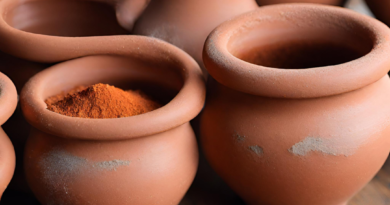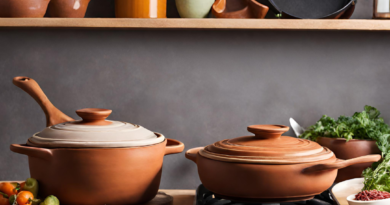How do you season a clay tagine?
Seasoning a clay tagine is an important step to prepare it for cooking and to develop its non-stick properties. Seasoning helps create a protective layer on the surface of the tagine, preventing food from sticking and enhancing the flavors of your dishes. Here’s how to season a clay tagine:
Ingredients and Equipment:
– Unseasoned clay tagine
– Water
– Olive oil
– Mild dish soap (optional)
– Soft brush or sponge
– Oven
Steps:
1. Inspect the Tagine: Before seasoning, make sure your clay tagine is unglazed and hasn’t been previously seasoned. If it’s brand new, it likely needs seasoning. If it has been used before, it may still benefit from re-seasoning if the surface has become less non-stick.
2. Soak the Tagine: Submerge the base and the lid of the tagine in water for at least 1 hour, or overnight if possible. This soaking allows the clay to absorb moisture and prevents it from cracking during seasoning.
3. Dry Thoroughly: Remove the tagine from the water and let it air dry completely. This can take several hours or overnight.
4. Coat with Olive Oil: Once the tagine is dry, rub the interior of both the base and the lid with a thin layer of olive oil. Use your hands or a soft cloth to evenly coat the entire interior surface, including the sides and bottom. Be generous with the oil but avoid excessive pooling.
5. Place in Cold Oven: Position the oiled tagine in a cold oven. This is crucial to prevent thermal shock. Do not preheat the oven with the tagine inside.
6. Set Temperature and Bake: Close the oven door and set the temperature to 300°F (150°C). Slowly heat the tagine for about 1 to 1.5 hours. The gradual increase in temperature allows the tagine to absorb the oil, and it will help develop a non-stick layer on the clay.
7. Cool Completely: After the initial heating, turn off the oven and let the tagine cool completely inside the oven. This step helps the oil bond with the clay surface.
8. Repeat Seasoning: Some people recommend repeating the seasoning process 2-3 times to build up a robust non-stick layer. This is optional but can further enhance the tagine’s performance.
9. Wash with Mild Soap: After seasoning, wash the tagine with mild dish soap and water. Use a soft brush or sponge to remove any residual oil or clay particles. Rinse thoroughly and let it air dry.
10. Ready to Use: Your clay tagine is now seasoned and ready for cooking. The more you use it, the better the non-stick surface will become.
Remember that with each use, the tagine will continue to develop its non-stick properties and enhance the flavors of your dishes. Additionally, avoid sudden temperature changes, such as placing a hot tagine on a cold surface, as this can lead to thermal shock and potentially crack the tagine.



